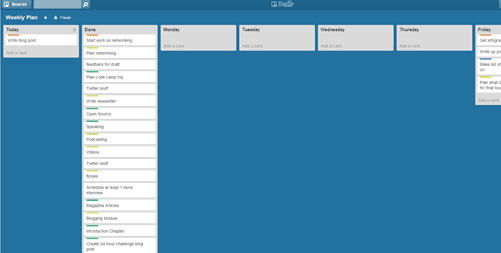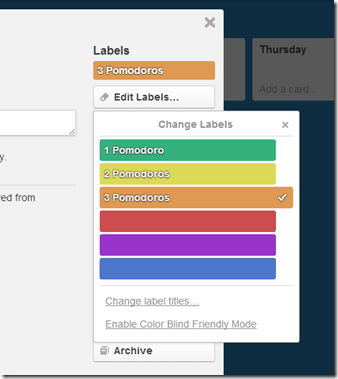In the last year, I:
- Created and produced 30 full length video courses for Pluralsight
- Wrote 56 blog posts
- Produced 40 episodes of the Get Up and CODE podcast
- Created 50 YouTube videos
- Published a book
- Spoke at 4 events
- Billed over 100 hours of contract work
- Created a full product, that I am about ready to launch
- Ran 5 kilometers 3 times a week, every week
- Lifted weights 3 times a week, every week
I'm not saying this to brag–although I am certainly proud of these accomplishments. I am saying these things to prove that I know what I am talking about when it comes to productivity.
Being super productive
Right now–as I type–I have a timer ticking down. The clock shows approximately 14 minutes before I'll take my next break. I live and die by this clock.
You may have guessed it, but the clock is a Pomodoro timer. For the last year, I've been religiously using the Pomodoro technique to not only stay on task, but to plan out my days and weeks.
If you aren't familiar with the Pomodoro technique, the concept is remarkably simple. So simple, that I first dismissed it as ridiculous. But, thanks to my good friend Josh Earl's success with it, I decided to give it another try.
You basically set a timer for 25 minutes. During that time you pick a single task to accomplish and work on that task, uninterrupted. After 25 minutes you take a break for 5 minutes and then begin again. After 4 cycles, you take a longer 15 minute break. (There are some variations on this, but that is the basic idea.)
Like I said, it seems pretty simple and unremarkable, but I can't even begin to express how powerful this technique is for getting things done.
I'm lazy by nature. I have to constantly fight against the side of me that wants to procrastinate and slough off my work. The Pomodoro technique helps keep me focused by forcing me to work uninterrupted for a period of time. It also gives me a measure to compare myself against and realistic targets to aspire to achieve.
My week
My week beings on Monday. On Monday morning I wake up and go to the gym to lift weights. When I get back, I have a protein shake and get to work.
The first thing I do when I get to my desk on Monday is start my Pomodoro timer and open up my “Weekly Plan” Trello board. I use this board to organize my week. It has nine columns. Seven columns for the days of the week, one column for today, and one column for done.
My first task of the day is to create the rest of the tasks that I think I can get done that week. I start off with a checklist of things that I know I need to do every week:
- Blog post
- Podcast episode
- YouTube video
- Newsletter email
- Buffer social network posts
Then, I add cards for the current projects I am working on for that week.
Once I've got all the cards I can think of on the board, I start tagging each card with a color that represents how many Pomodoros I think that task will take. I have three categories:
- Green: 1 Pomodoro
- Yellow: 2 Pomodoros
- Orange: 3 Pomodoros
If something is going to take up more than three Pomodoros worth of time, it needs to be split into multiple tasks.
Next up is planning the week. For each day of the week–unless there is something that will take up most of my time–I figure I can get about 10 Pomodoros done. This may not seem like a lot, but believe me, it is. I drag cards into the columns until I have filled up each weekday with 10 Pomodoros worth of cards. For weekends, I usually just drag in about three or four.
My estimates are always on the high side, but they are pretty accurate, because it is fairly easy to estimate based on half hour intervals–especially when many of your tasks are repeated each week. (For example, a blog post is estimated at three Pomodoros.)
My day
I have a similar ritual every single day. The first thing I do, after exercising each day, is to open up my Trello board again and this time plan the day.
New things come up and other things need to get shifted around, so planning for the week alone is not sufficient. Often, I'll have different tasks that I had vaguely identified at the beginning of the week which I'll give more clarity to later on.
I first drag things over from the appropriate day into my “Today” column until that column is filled with about 10 Pomodoros worth of work. After that, I'll take a look at the today columns and think about anything I might have missed that needs to get done that day. Finally, I'll sort the “Today” column based on priority–I want to make sure I am always working on the most important things first.
Once I've got the day sorted out, I go back to the rest of the days in the week and move around cards until everything is balanced again. If I find that I've got some empty slots, I'll create new cards and start filling those slots until I am back at full capacity again.
Once all the prep-work is done, it's time to actually start working on tasks. I grab the first task off the list, start a timer and get to work. At about 5:00, I stop for the day and add up my Pomodoros. If I didn't hit at least 10, I count on working a little bit that evening. If I did hit 10, it's optional.
Why this works
So, you may be wondering why this works–why it is worth even writing about such a simple workflow. Well, even though this workflow seems really simple, there are a few key things going on here that aren't immediately obvious.
First of all, I am using quotas to make sure that I accomplish the volume of work that I want to produce each week. I have quotas for how many blog posts, podcasts, YouTube videos, and other content that I need to produce each week. The things that are being measured by a quota get dropped onto my board first.
I'm also using a daily and weekly quota when it comes to Pomodoros. Pomodoros are little measurable units of work for me. I know that I should be able to get 10 done each day and that I should be able to get roughly 50 done in a week without killing myself. I know from experience that hitting 60-70 will cause a measurable dip in performance the next week and that if I am doing less than 50, I am slacking off.
Because I have those quotas in place, I know what is expected of me each and every week. I have the power to hold myself accountable to a real measurable standard. I can't emphasize enough how important this point is. If you don't have a way to hold yourself accountable to a standard that you want to achieve, human nature will cause you to fall way below the bar.
Another major component that makes this technique successful is the awareness of my capacity within a given amount of time. It is really easy to over or under estimate what you can get done in week, because you don't normally have a ruler that you can use to measure task duration versus your actual capacity. When I start the week, I know that my capacity is about 50–I've got that much gas in my car. I get to choose where I want to drive that car that week–I can only go so far. I have to make a realistic prediction of what I can actually get done. From that prediction I have to prioritize my tasks so that the most important things get done first.
Without this understanding of my capacity, it is easy to fall into the trap of overestimating my ability to get work done and underestimating the take it will take to get the work done. With this system, I have a real metric to compare to. I know that I am not going to get 80 Pomodoros done in a week. I know that in an 8 hour day, I will not get 8 hours of work done. I am eliminating my biases by replacing them with real statistics.
Finally, the dedicated focus of the Pomodoro technique makes me more efficient at the work I am doing. When I am solely focused on one task at a time–without checking Facebook or Twitter–I work much more efficiently. Several studies have shown that multitasking causes a drop in efficiency. When I stay focused on a single task, I get much more done. I've written about this before, when I talked about quitting your job, but you can easily lose hours of time in a day to small distractions. Over the period of a year's worth of time, all those wasted minutes can end up equaling weeks of lost productivity.
The benefits
One huge benefit of this technique is that I am able to do most of this work without stress or guilt. Normally, when I am working, I always feel guilty about how much time I am wasting during the day. I also feel stressed about not getting as much done as I should be getting done. This situation of stress and guilt actually ends up being the perfect breeding ground for procrastination and burnout.
When I am using the Pomodoro technique, I don't feel the guilt of wasting time, because I know that as long as I get done 10 Pomodoros in a day I have reached my productivity goal for the day. If I get more done, great.
I also don't feel stressed about getting as much done as I should have, because how much I get done is no longer what is being measured–I've taken the burden off of my shoulders. My focus has shifted from results to process. I can't control the results. Work takes as long as work takes. But, I can control the process. If I put in my 10 Pomodoros for the day and I have sufficiently prioritized my work, then I have done the best that I can do–no need for guilt, shame or stress.
Time for a break
If you are interested in getting started with the Pomodoro technique, I'd recommend checking out Pomodoro Technique Illustrated. And if you have any questions about my process and how it works, feel free to ask and I am happy to answer them in the comments below.
Also, if you liked this post and are interested in more of what I have to say about being productive and boosting your career, sign up for my weekly newsletter here. You also might want to check out the course I am putting together called “How To Market Yourself as a Software Developer.”




